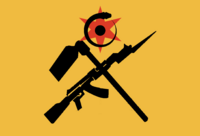Hsan Salvation Front
| Hsan Salvation Front | |
|---|---|
| ရှမ်းကယ်တင်ခြင်းတပ် ဦး Kaaltainhkyinntaut Hsan U | |
 | |
| Active | 1960-1971 |
| Allegiance | |
| Type | Pro-Government Paramilitary Force |
The Hsan Salvation Front was a pro-Confederal ethnic militia that became the main fighting force of the Royalist Coalition in the Trucial Wars. The group sought to defend the dominant Hsan-Lue minority of Zomia from the agricultural collectivisation and mass relocation inflicted by the People's Republican Army on occupied territories. With the loss of the capital in 1959, and the destruction or absorption of most of the Confederal State's Tribal Protection Units by the PRA, the military situation in 1960 was dire. Lue tribes feared imminent extermination at the hands of the predominantly ethnic Ryo leadership of the United Zomi Councils, a dispossessed people that harboured longstanding resentment towards the Hsan-Lue for their collaboration with Weranian colonial governments in the Trucial Era.
The HSF's origins from the multi-sided inter-tribal fighting in Confederal Zomia are unclear, but according to its own propaganda, the group was founded by a band of Badi warrior-monks fleeing the destruction of their temples by the PRA after the Fall of Yotkuy, the so-called Long March of Tears. This remains the official position of the modern Union government of Zomia, though the broad consensus of Euclean and Asterian historians is that this founding myth was created to mitigate the disgrace of its actual leaders: Royal Officers that had surrendered to the PRA at Yotkuy rather than fight to the death, and later escaped from UZC labour camps. The HSF's religious propaganda was nonetheless highly successful: at its height the group commanded over 20,000 militants organised into a hundred and fifteen regional armies, more double the numbers of any other Confederal paramilitary group.
The Hsan Salvation Front's ideology was a combination of indigenous Badi-Zohist syncretism and reactionary authoritarianism. The group promulgated a fetishistic personality cult surrounding Prince Paramount Hpkeng II, considered their spiritual leader, and commanders swore theatrical blood-oaths to the Paramountcy-in-Exile at mass executions of captured Ryo civilians. Such shows of loyalty won the HSF the favour of the Confederal Government, which supplied it with more weapons and equipment than any other group, but this support came at the cost of its reputation. Although scholars have long argued over whether the Ryo committed genocide against the Hsan-Lue, with over a million dying from famine and over-work in UZC agricultural communes, it was the HSF's bloody reprisals and eccentric leadership that drew international condemnation during the war itself.
Towards the end of the Trucial Wars, an increasingly destructive rivalry developed between the HSF and the United Army of the Liberation, a multi-ethnic alliance composed of mutinous PRA Labour Battalions and the scattered guerrilla forces of the Confederal Tribal Protection Units. They clashed with each other as much as the PRA in their race to retake Yotkuy in 1970. It is believed Hpkeng II originally intended for the HSF to destroy the UAL once the war against the UZC was won, fearing a threat to Lue minority rule, and he had prohibited the supplying of arms to the UAL in 1968. As the HSF's indiscriminate violence towards the Paramountcy's hard-won allies increased, however, their loyalty and discipline was called into question. The final straw for the HSF came several months after Confederal-Royalist victory at Yotkuy - following the disastrous Teyvada Crossing Incident of 1971. Emboldened by anti-socialist unrest in neighbouring Lavana, HSF militants deserted their lines and looted Lavanan villages across the border - drawing several hundred militia and a patrol group of Trucial Rangers into a bloody confrontation with the Lavanan Army. The diplomatic repercussions - and the HSF's militants' defeat and surrender - was a great humiliation for Hpkeng II's newly established Union regime, and he swiftly ordered the leadership of the HSF purged. UAL forces led the arrests, and against all prior expectation, it was ultimately their organisation that would be consolidated into the Union Defence Force, the modern armed forces of Zomia.